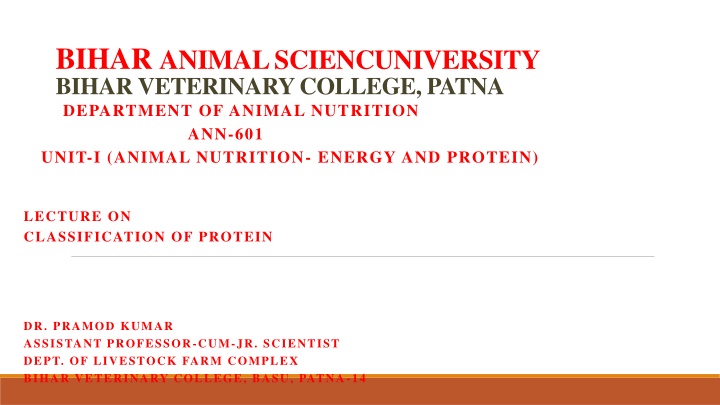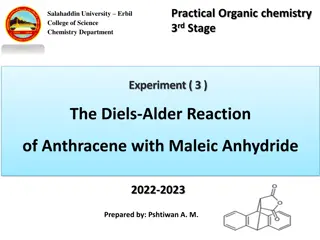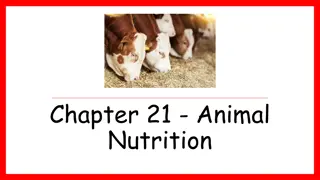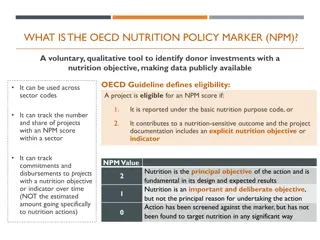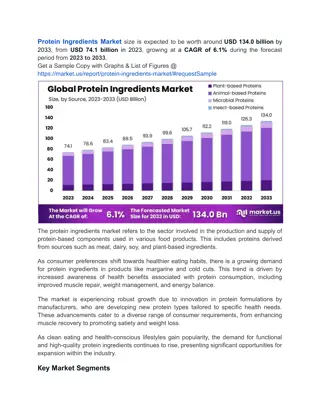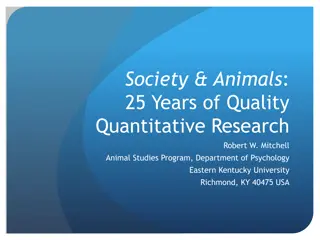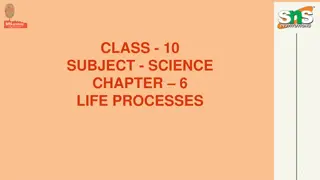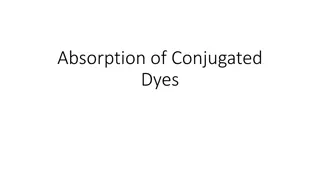Classification of Proteins in Animal Nutrition: Simple Proteins vs. Conjugated Proteins
Proteins in animal nutrition are classified into two main groups: simple proteins and conjugated proteins. Simple proteins can be further divided into fibrous and globular proteins based on their shape, solubility, and chemical composition. Fibrous proteins, such as collagens, elastin, and keratins, have structural roles in animal tissues and are insoluble. On the other hand, globular proteins are enzymes, antigens, and hormones with compact folded structures. Conjugated proteins contain a non-protein moiety along with amino acids. Examples include glycoproteins, lipoproteins, phosphoproteins, and chromoproteins.
Download Presentation

Please find below an Image/Link to download the presentation.
The content on the website is provided AS IS for your information and personal use only. It may not be sold, licensed, or shared on other websites without obtaining consent from the author.If you encounter any issues during the download, it is possible that the publisher has removed the file from their server.
You are allowed to download the files provided on this website for personal or commercial use, subject to the condition that they are used lawfully. All files are the property of their respective owners.
The content on the website is provided AS IS for your information and personal use only. It may not be sold, licensed, or shared on other websites without obtaining consent from the author.
E N D
Presentation Transcript
BIHAR ANIMAL SCIENCUNIVERSITY BIHAR VETERINARY COLLEGE, PATNA DEPARTMENT OF ANIMAL NUTRITION ANN-601 UNIT-I (ANIMAL NUTRITION- ENERGY AND PROTEIN) LECTURE ON CLASSIFICATION OF PROTEIN DR. PRAMOD KUMAR ASSISTANT PROFESSOR-CUM-JR. SCIENTIST DEPT. OF LIVESTOCK FARM COMPLEX BIHAR VETERINARY COLLEGE, BASU, PATNA-14
CLASSIFICATION OF PROTEINS Proteins may be classified into two main groups: simple proteins and conjugated proteins. 1. Simple Protein - These proteins produce only amino acids on hydrolysis. They are subdivided into two groups, fibrous and globular proteins, according to shape, solubility and chemical composition. A. Fibrous Protein These proteins, which in most cases have structural roles in animal cells and tissues, are insoluble and are very resistant to animal digestive enzymes. They are composed of elongated filamentous chains joined together by cross-linkages. The group includes collagens, elastin and keratins.
Collagens - are the main proteins of connective tissues and constitute about 30 per cent of the total proteins in the mammalian body. The amino acid hydroxyproline is an important component of collagen. Hydroxylation of proline to hydroxyproline involves vitamin C; if this vitamin is deficient, collagen fibres are weakened and may give rise to gum and skin lesions . The indispensable amino acid tryptophan is not found in these proteins. Elastin is the protein found in elastic tissues such as tendons and arteries. The polypeptide chain of elastin is rich in alanine and glycine and is very flexible. It contains cross-links involving lysine side chains, which prevent the protein from extending excessively under tension and allow it to return to its normal length when tension is removed. Keratins are classified into two types. The -keratins are the main proteins of wool and hair.The -keratins occur in feathers, skin, beaks and scales of most birds and reptiles. These proteins are very rich in the sulphur-containing amino acid cysteine; wool protein, for example, contains about 4 per cent of sulphur .
B. Globular Proteins Globular proteins are so called because their polypeptide chains are folded into compact structures. The group includes all the enzymes, antigens and those hormones that are proteins. Its first subgroup, albumins, are water-soluble and heat-coagulable and occur in milk, the blood, eggs and many plants. Histones are basic proteins that occur in cell nuclei, where they are associated with DNA. They are soluble in salt solutions, are not heat-coagulable, and on hydrolysis yield large quantities of arginine and lysine. Protamines are basic proteins of relatively low molecular weight, which are associated with nucleic acids and are found in large quantities in the mature male germ cells of vertebrates. Protamines are rich in arginine but contain no tyrosine, tryptophan or sulphur-containing amino acids. Globulins occur in milk, eggs and blood, and are the main reserve protein in many seeds.
2. Conjugate Proteins Conjugated proteins contain, in addition to amino acids, a non-protein moiety termed a prosthetic group. Some examples of conjugated proteins are glycoproteins, lipoproteins, phosphoproteins and chromoproteins. Glycoproteins - are proteins with one or more heteroglycans as prosthetic groups. In most glycoproteins the heteroglycans contain a hexosamine, either glucosamine or galactosamine or both; in addition, galactose and mannose may also be present. Glycoproteins are components of mucous secretions, which act as lubricants in many parts of the body. The storage protein in egg white, ovalbumin, is a glycoprotein. Lipoproteins - which are proteins conjugated with lipids such as triacylglycerols and cholesterol, are the main components of cell membranes and are also the form in which lipids are transported in the bloodstream to tissues, either for oxidation or Nucleic acids 63 for energy storage. They can be classified into five main categories in increasing order of density: chylomicrons, very-low-density lipoproteins (VLDL), low-density lipoproteins (LDL), intermediate-density lipoproteins (IDL) and high-density lipoproteins (HDL) .
Phosphoproteins - which contain phosphoric acid as the prosthetic group, include the caseins of milk and phosvitin in egg yolk. Chromoproteins - contain a pigment as the prosthetic group. Examples are haemoglobin and cytochromes, in which the prosthetic group is the iron-containing compound haem, and flavoproteins, which contain flavins . NUCLEIC ACIDS Nucleic acids are high-molecular-weight compounds that play a fundamental role in living organisms as a store of genetic information. Nucleic acids are polynucleotides of very high molecular weight, generally measured in several millions. A nucleotide containing ribose is termed ribonucleic acid (RNA), while one containing deoxyribose is referred to as deoxyribonucleic acid (DNA). DNA normally consists of a double-strand spiral or helix. Each strand consists of alternate units of the deoxyribose and phosphate
Attached to each sugar group is one of the four bases, cytosine, thymine, adenine or guanine. The bases on the two strands of the spiral are joined in pairs by hydrogen bonds, the thymine on one strand always being paired with the adenine on the other and the cytosine with the guanine. The sequence of bases along these strands carries the genetic information of the living cell. DNA is found in the nuclei of cells as part of the chromosome structure. There are several distinct types of ribonucleic acid, which are defined in terms of molecular size, base composition and functional properties. They differ from DNA in the nature of their sugar moiety and also in the types of nitrogenous base present. RNA contains the pyrimidine uracil in place of thymine. There is evidence to indicate that unlike DNA, most RNA molecules exist in the form of single, folded chains arranged spirally. There are three main forms of RNA, termed messenger RNA, ribosomal RNA and transfer RNA. On hydrolysis, nucleic acids yield a mixture of basic nitrogenous compounds (purines and pyrimidines), a pentose (ribose or deoxyribose) and phosphoric acid. The main pyrimidines found in nucleic acids are cytosine, thymine and uracil. The relationships between these compounds and the parent material, pyrimidine.
Diagrammatic representation of part of the ladder-like DNA molecule, showing the two strands of alternate phosphate (P) and deoxyribose (D) molecules. The horizontal rods represent the pairs of bases held by hydrogen bonds (represented by dotted lines). A = adenine, T = thymine, C = cytosine, G = guanine.
The compound formed by linking one of the above nitrogenous compounds to a pentose is termed a nucleoside. For example:
Other Nitrogenous Compounds A considerable variety of nitrogen-containing compounds, other than proteins and nucleic acids, occur in plants and animals. In plants, free amino acids are usually present; those in greatest amount include glutamic acid, aspartic acid, alanine, serine, glycine and proline. Other compounds are nitrogenous lipids, amines, amides, purines, pyrimidines, nitrates and alkaloids. In addition, most members of the vitamin B complex contain nitrogen in their structure. Amines Amines are basic compounds present in small amounts in most plant and animal tissues. Many occur as decomposition products in decaying organic matter and have toxic properties. A number of microorganisms are capable of producing amines by decarboxylation of amino acids. These may be produced in the rumen under certain conditions and can occur in fermented foods such as cheese, wine, sauerkraut and sausage.
They are termed biogenic amines and may give rise to physiological symptoms; histamine, for example, is an amine formed from the amino acid histidine and in cases of anaphylactic shock is found in the blood in relatively large amounts. Histamine has also been implicated in dietary-induced migraine. In contrast to the harmful biogenic amines, the polyamines putrescene, spermidine and spermine are necessary for optimal growth and function of cells. They are involved in DNA, RNA and protein synthesis, regulation of gene expression, enzyme activity, cell proliferation and cell signalling. Several metabolic pathways (e.g. lipid metabolism, creatine and carnitine synthesis) require methyl groups and these can be supplied by choline or methionine. During the process of transmethylation, betaine, a tertiary amine, is formed by the oxidation of choline. Betaine occurs in sugar beet, and the young leaves may contain about 25 g/kg; it is this amine that is responsible for the fishy aroma .
Some important amines and their parent amino acids Amino Acid Amine Arginine Putrescine Histidine Histamine Lysine Cadaverine Phenylalanine Phenylethylamine Tyrosine Tyramine Tryptophan Tryptamine
Amides Asparagine and glutamine are important amide derivatives of the amino acids aspartic acid and glutamic acid. These two amides are also classed as amino acids and occur as components of proteins. They also occur as free amides and play an important role in transamination reactions. Urea is an amide that is the main end product of nitrogen metabolism in mammals, but it also occurs in many plants and has been detected in wheat, soya bean, potato and cabbage. In humans and other primates, uric acid is the end product of purine metabolism and is found in the urine. In subprimate mammals the uric acid is oxidised to allantoin before being excreted. In birds, uric acid is the principal end product of nitrogen metabolism and thus corresponds, in its function, to urea in mammals.
Nitrates Nitrates may be present in plant materials and, whereas nitrate itself may not be toxic to animals, it is reduced readily under favourable conditions, as in the rumen, to nitrite, which is toxic. Oat hay poisoning is attributed to the relatively large amounts of nitrate present in green oats. Quite high levels of nitrate have been reported in herbage given heavy dressings of nitrogenous fertilisers .
ALKALOIDS These compounds are of particular interest since many of them have poisonous properties. In plants, their presence is restricted to a few orders of the dicotyledons. The alkaloid in ragwort, for example, attacks the liver and much of this organ can be destroyed before symptoms appear. Another nutritionally significant source of alkaloids is the fungus ergot, which grows on cereal grains
Some importmant alkaloids occurring in plants Name Coniine Source Hemlock Nicotine Tobacco Ricinine Castor plant seeds Atropine Deadly nightshade Cocaine Leaves of coca plant Jacobine Ragwort Quinine Cinchona bark Strychnine Seeds of Nuxvomica Morphine Dried latex of opium poppy Solanine Unripe potatoes and potato sprouts
